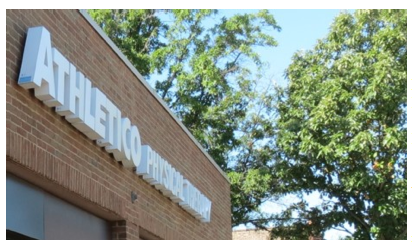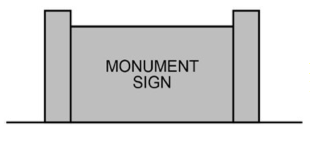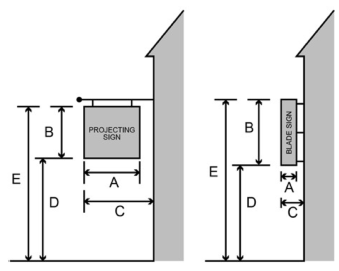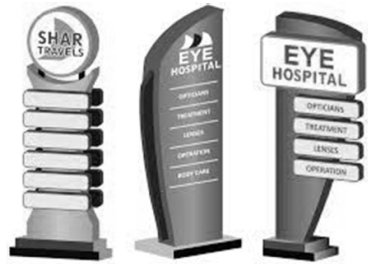For the purpose of this chapter, the following definitions shall apply:
AWNING: A fabric, plastic, metal or other structural protective cover which extends over a building entrance, window or walkway in order to provide protection from the elements. Awnings are supported from the walls of a structure.
AWNING SIGN: A sign that is mounted, painted, or otherwise applied on or attached to an awning.
BANNER SIGN: Any cloth, bunting, plastic, paper, or similar material used for advertising or identification purposes attached to any structure.
BOX OR CABINET SIGN: A sign that contains all the text and/or logo symbols within a single enclosed cabinet and which may or may not be illuminated.
FIGURE 1: EXAMPLES OF BOX OR CABINET SIGNS

CANOPY: A fabric, plastic, metal or other structural protective cover which extends over a building entrance, window or walkway in order to provide protection from the elements, or as commonly found over outdoor eating areas, gasoline service station service areas and other drive through facilities. Canopies are supported from the ground, deck or floor. Canopies may be attached to and receive support from the wall of a structure, or be freestanding.
CANOPY SIGN: A sign that is mounted, painted, or otherwise applied on or attached to a canopy.
COPY: The wording or symbols on a sign surface, either in permanent or changing letter form.
DIRECTORY SIGN: A sign listing the names and locations of businesses within a building that does not have first-floor frontage, or a sign displaying announcements that direct attention to a public charitable or religious facility located on the lot of such facility.
ENTRY SIGN: A sign located over an entry to a business that does not face a public street, is not visible from a public street and is intended to allow access to the business from a parking lot or walkway.
EXEMPT SIGN: A sign which, due to its small size or unobtrusive nature, is not regulated by this chapter. "Exempt signs" are specifically listed within this chapter.
EXTERNAL ILLUMINATION: Illumination of a sign by a source of light not contained within the sign itself.
FEATHER SIGN: A temporary sign constructed of a single vertical pole, either freestanding with supports or temporarily mounted on a wall, with an attached pennant that is vertically elongated and attached to the pole and is designed to, or which actually does, wave or move in the wind.
Figure 1: Example of a Freestanding Feather Sign

Figure 2: Example of a Wall-Mounted Feather Sign

GROUND SIGN: A sign erected in or resting upon the ground and mounted on self-supporting structures not attached to a building.
IDENTIFICATION SIGN: A sign directing attention to the name of an office, institution, multiple-family building, business, product, service or activity conducted or sold on the lot where the sign is displayed, and classified as to design and structure as an awning, canopy, monument, projecting, wall, or window sign.
ILLUMINATED SIGN: A sign which emanates or receives light transmitted either internally or externally.
INDIVIDUAL LETTER SIGN: A sign made of individual letters or graphics that is mounted directly on the wall of a building.
FIGURE 2: EXAMPLE OF AN INDIVIDUAL LETTER SIGN

INSTRUCTIONAL SIGN: A sign notifying or instructing the public as to limitations or regulations relating to designated uses of certain parcels of property or public or private streets or rights-of-way.
INTERNAL ILLUMINATION: Illumination of a sign by a source of light that is contained within the sign itself.
MONUMENT SIGN: A ground sign for which the base/supports on all sides are one hundred percent (100%) in contact with the ground and whose width of the base is at least as wide as the width of the top of the sign.
FIGURE 3: EXAMPLE OF A MONUMENT SIGN

MURAL: A picture or photograph painted or applied directly on a wall which contains no wording or letters of any written language and in which no way identifies a product or contains any commercial messaging, advertising, logos, or business identification messages.
NAMEPLATE: A small, wall mounted, nonelectronic sign no more than four inches (4") in depth identifying a business or occupant located on the premises on which the sign is located.
NATURAL GRADE: Refer to Figure 11 in Section 4-3-7.
NEON SIGN: An illuminated sign consisting of a neon tube that is bent to form letters, symbols, or other shapes, or in which some other device is used to simulate a neon tube and neon tube illumination. This definition also applies to “neon tubing”, “neon window sign”, and “neon window lighting”.
OFF-PREMISES SIGN: A sign which advertises or otherwise relates to goods, services, or facilities that are not available on the premises where the sign is located. This definition includes (but is not limited to) billboards.
PERMANENT SIGN: Any sign except an exempt sign and a temporary sign as listed in this chapter. Such signs are intended to be used indefinitely, or used indefinitely without change in the same state or place.
PERMANENT WINDOW SIGN: A window sign, installed as a secondary sign within six feet (6') of the window, constructed of permanent materials for which a sign permit has been issued.
POLE SIGN: A sign that is mounted on a freestanding pole or other support so that the bottom edge of the sign face is six feet or more above grade. These signs are composed of the sign cabinet or base and the sign pole or pylon by which it connects to the ground. The freestanding pole may be a post, pole, brace, standard, or other upright member, usually made of metal, used singly or in combination to structurally support a freestanding sign. A pole differs from a pylon in that the form is structurally narrower than the latter. A pylon is comprised of a pole enclosed with a metal cover or completely concealed by surrounding masonry, stone, or other secure, permanent material, or a masonry or stone column.
FIGURE 4: EXAMPLE OF A POLE SIGN

PROJECTING/BLADE SIGN: Any sign other than a wall sign that is attached to, and extends or projects from the face of the wall of the building to which it is affixed. Projecting signs are oriented horizontally and blade signs are oriented vertically. No guy lines, braces or secondary supports shall be used. Any angle iron or main support shall be enclosed in a wood, plastic or metal form, such that the angle iron or main support for the sign is not visible. A projecting/blade sign may not be constructed as a box sign.
FIGURE 5: DRAWINGS OF PROJECTING AND BLADE SIGNS

A: Width of sign.
B: Height of sign.
C: Furthest distance sign protrudes from wall.
D: Distance from ground to bottom of sign.
E: Distance from ground to top of sign.
These measurements are utilized when calculating sign area and sign height.
FIGURE 6: EXAMPLE OF A PROJECTING SIGN

FIGURE 7: EXAMPLE OF A BLADE SIGN

PYLON SIGN: A freestanding sign supported by one or more piers and not attached to a building, typically vertical in orientation with a continuous enclosure, and including a detached sign framework supported on one or more piers to which sign infills or wraps can be added. A pylon is a column used singly or in combination to structurally support a freestanding sign that is substantially wider than a pole, and that consists of a pole that has been boxed-in or enclosed with a metal pole cover or completely concealed by surrounding masonry, stone, or other secure, permanent material, or a masonry or stone column. A pylon differs from a pole in that the former is structurally wider and enclosed compared to the latter.
FIGURE 8: EXAMPLES OF PYLON SIGNS

READER BOARD: Any sign that provides for a changeable message either through the use of individual changeable letters or some other means such as an electronically displayed message. Manual, digital or LED displays of fuel prices shall not be considered to be reader board signs.
ROOF SIGN: A sign erected or maintained in whole or in part upon or over the roof of a building.
SANDWICH BOARD SIGN: A two (2) sided movable sign which opens at the bottom and is joined at the top and which is intended to be placed on the ground.
SECONDARY SIGN: A sign intended primarily for viewing by pedestrian traffic, displayed as a window sign or window display or a canopy or awning sign.
SIGN: Any object, device, display or structure, or part thereof, which is used to advertise, identify, display, direct or attract attention to an object, person, institution, organization, business, product, service, event, or location by any means including words, letters, figures, designs, symbols, fixtures, colors or illumination whether affixed to a building or separate from any building. Murals, as defined herein, shall not be considered signs, but are subject to the requirements of Section 4-3-17.
SIGN AREA: See Section 4-3-7 of this chapter.
SIGN HEIGHT: See Section 4-3-7 of this chapter.
SIGN STRUCTURE: The sign and all parts associated with its mounting.
SIGN SUPPORTS: All structural features by which a sign is held up, including, for example, poles, braces, guys, and anchors.
SIGN SURFACE AREA: The area within any perimeter enclosing the limits of lettering, emblems or other figures on a sign, together with any material or color forming an integral part of the display or used to differentiate the sign from the background against which it is placed. Structural members bearing no sign copy shall not be included in a sign's surface area.
SILHOUETTE ILLUMINATION: Internal illumination of a sign that casts or reflects light behind the sign so as to create a silhouette or halo around the outer perimeter of the sign. Sometimes referred to as "halo" illumination.
TEMPORARY SIGN: A sign which is intended to be displayed for a limited time only. Such signs include, but are not limited to, real estate signs, political signs, special event signs, holiday decorations and construction signs. Temporary signs, other than political signs in residential zoning districts, shall be removed within seven (7) days after their purpose has been fulfilled (e.g., property sold, construction completed, etc.).
TEMPORARY SIGN, BUSINESS IDENTIFICATION: A business sign that is used for a newly-opened or relocated business prior to the arrival of its permanent signage; or a temporary business that is housed in a permanent building.
TEMPORARY WINDOW SIGN: A temporary sign attached to the window or as a window display.
WALL SIGN: A sign painted upon, or attached to and supported by the outside surface of a wall of a building or structure in a plane parallel to that of the supporting wall.
WINDOW DISPLAY SIGN: One or more signs in a display window which are incorporated with a display or merchandise or relating to services offered but which are not affixed to any window.
WINDOW SIGN: A sign which is affixed to or in contact with, or within six feet (6') of a window or the glass surface of a door, and is visible from the public street. (Ord. 2874, 4-16-2015; amd. Ord. 2967, 9-21-2017; Ord. 4023, 7- 7-2022; Ord. 4048, 2-16-2023; Ord. 4088, 2-15-2024)